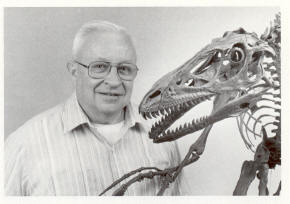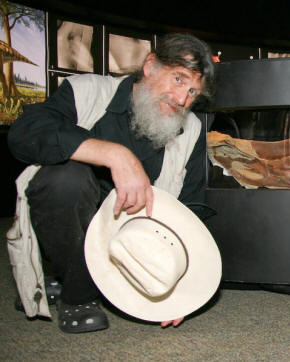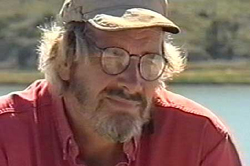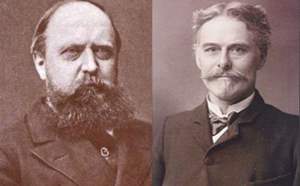|
The Bone Wars
The Bone Wars, also known as the "Great Dinosaur Rush",
refers to a period of intense fossil speculation and discovery during the
Gilded
Age of
American history, marked by a heated rivalry between
Edward Drinker Cope (of the
Academy of Natural Sciences in Philadelphia) and
Othniel Charles Marsh (of the
Peabody Museum of Natural History at Yale). Each of the two
paleontologists used underhanded methods to try to out-compete the other
in the field, resorting to bribery, theft, and destruction of bones. Each
scientist also attacked the other in scientific publications, seeking to
ruin his credibility and have his funding cut off.
Their search for fossils led them west to rich
bone beds
in Colorado, Nebraska, and Wyoming. From 1877 to 1892, both paleontologists
used their wealth and influence to finance their own expeditions and to
procure services and dinosaur bones from fossil hunters. By the end of the
Bone Wars, both men had exhausted their funds in the pursuit of
paleontological supremacy.
Cope and Marsh were financially and socially ruined by their attempts to
disgrace each other, but their contributions to science and the field of
paleontology were massive, and provided substantial material for further
work—both scientists left behind many unopened boxes of fossils after their
deaths. The efforts of the two men led to over 142 new species of dinosaurs
being discovered and described. The products of the Bone Wars resulted in an
increase in knowledge of
prehistoric life, and sparked the public's interest in dinosaurs,
leading to continued fossil excavation in North America in the decades to
follow. Several historical books and fictional adaptations have been
published about this period of intense fossil-hunting activity.
For the complete story, visit
Wikipedia's Bone Wars
page.
The Dinosaur Renaissance
The dinosaur renaissance was a
small-scale
scientific revolution
that started in the late 1960s, and led to renewed academic and popular
interest in dinosaurs. It was sparked by new discoveries and research
indicating that dinosaurs may have been active and
warm-blooded animals,
rather than
cold-blooded and
sluggish as had been the prevailing view and description during the first
half of the twentieth century.
The new view of dinosaurs was
championed by John Ostrom, who argued that birds evolved from
coelurosaurian
dinosaurs, and particularly Robert Bakker who
argued passionately that dinosaurs were warm-blooded in a way
similar to modern mammals and birds. Bakker
frequently portrayed his ideas as a renaissance of those popular in the late
nineteenth century, referring to the period in between the wars as "the
dinosaur doldrums".
The dinosaur renaissance led to a
profound shift in thinking on nearly all aspects of dinosaur biology,
including
physiology, evolution, behaviour, ecology and extinction. It has also
led to multiple depictions of dinosaurs in popular culture.
Famous Paleontologists
Dr. John Ostrom
John H. Ostrom (February 18, 1928 – July 16, 2005) was an
American paleontologist who
 |
revolutionized modern understanding of dinosaurs in the 1960s, when he
demonstrated that dinosaurs are more like big non-flying birds than they are
like lizards (or "saurians"), an idea first proposed by Thomas Henry Huxley
in the 1860s, but which had garnered few supporters. The first of Ostrom's
broad-based reviews of the osteology and phylogeny of the primitive bird
Archaeopteryx appeared in 1976. His reaction to the eventual discovery
of feathered dinosaurs in China, after years of acrimonious debate, was
bittersweet.
His 1964 discovery of
Deinonychus is considered
one of the most important fossil finds in history.
Deinonychus was an active
predator that clearly killed its prey by leaping and slashing or stabbing
with its "terrible claw". Evidence of a truly active lifestyle included long
strings of muscle running along the tail, making it a stiff counterbalance
for jumping and running. The conclusion that at least some dinosaurs had a
high metabolism, and thus were at least partially warm-blooded, was
popularized by his student Robert T. Bakker, and changed the impression of
dinosaurs as cold-blooded, sluggish and slow lizards which had prevailed
since the turn of the century.
This changed how dinosaurs are
depicted by both professional dinosaur illustrators, and in the public eye.
The find is also credited with triggering the "dinosaur renaissance", a term
coined in a 1975 issue of Scientific American
by Bakker to describe the renewed debates causing an influx of interest in
paleontology, which has lasted from the 1970s to the present and has doubled
recorded dinosaur diversity.
Dr. Bob Bakker
Robert T. Bakker is an American
paleontologist who helped reshape modern
 |
| |
theories about
dinosaurs,
particularly by adding support to the theory that some dinosaurs were
endothermic (warm-blooded). Along with his mentor
John
Ostrom, Bakker was responsible for initiating the ongoing "dinosaur
renaissance" in paleontological studies, beginning with Bakker's article
"Dinosaur Renaissance" in Scientific American, April 1975. His
special field is the
ecological context and behavior of dinosaurs.
Bakker has been a major proponent of the theory that dinosaurs were
"warm-blooded", smart, fast, and adaptable. He published his first paper on
dinosaur endothermy in 1968. His seminal work,
The Dinosaur Heresies, was published in 1986. He revealed the first
evidence of parental care at nesting sites for
Allosaurus. Bakker was among the advisors for the film
Jurassic Park and for the 1992 PBS series,
The Dinosaurs. He also observed evidence in support of
Eldredge's and
Gould's theory of
punctuated equilibrium in dinosaur populations. Bakker currently serves
as the Curator of Paleontology for the Houston Museum of Natural Science.
Bakker is an ordained minister, who sees no conflict
between his belief in both God and evolution.
Dr. Jack Horner
John "Jack" R. Horner is an American
paleontologist who discovered and named
 |
Maiasaura,
providing the first clear evidence that some dinosaurs cared for their
young. He is one of the best-known paleontologists in the United States. In
addition to his many paleontological discoveries, Horner served as the
technical advisor for all of the Jurassic Park
films, and even served as partial inspiration for one of the lead
characters, Dr. Alan Grant.
In Montana during the mid-1970s,
Horner and his research partner Bob Makela discovered a colonial nesting
site of a new dinosaur genus which they named
Maiasaura, or "Good Mother Lizard". It contained
the first dinosaur eggs in the Western hemisphere, the first dinosaur
embryos, and settled questions of whether some dinosaurs were sociable,
built nests and cared for their young. The discovery established his career.
Horner has named several other species of dinosaur (including
Orodromeus makelai
in memory of his late friend Bob Makela) and has had two named after him:
Achelousaurus horneri
and
Anasazisaurus horneri.
Within the paleontological
community, Horner is best known for his work on the cutting edge of dinosaur
growth research. He has published numerous articles in collaboration with
Berkeley paleontologist Kevin Padian, and French dinosaur histologist Armand
Ricqlés, on the growth of dinosaurs using growth series. This usually
involves leg bones in graduated sizes from different individuals ranging in
age from embryos to adults. Currently, he is working on the developmental
biology of dinosaurs
Return to the
Old Earth Ministries Online Dinosaur
Curriculum homepage.

|



